Hokkaido





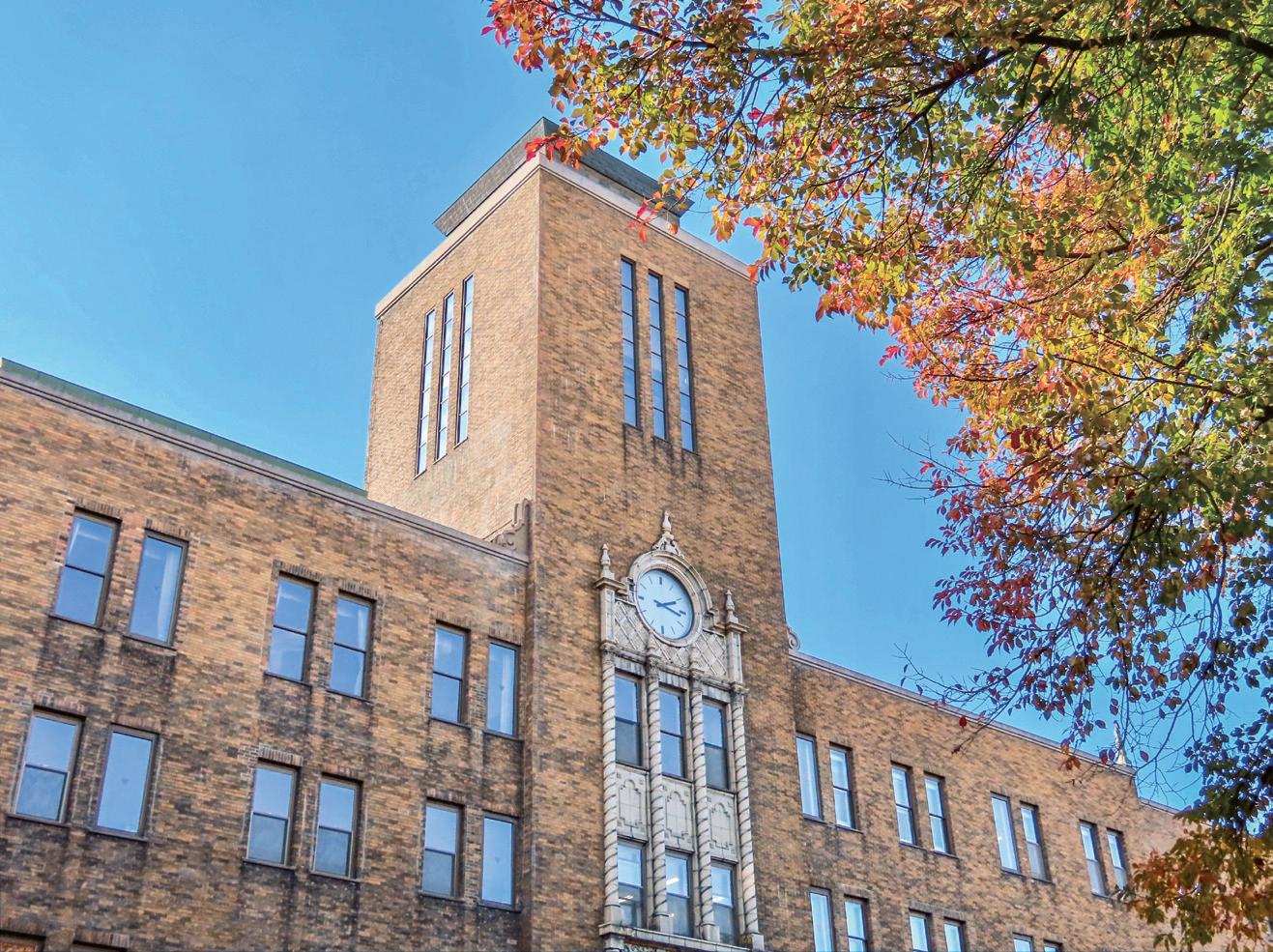 The Hokkaido University Financial Report will be published as the Hokkaido University Integrated Report from the 2022 edition.
The Hokkaido University Financial Report will be published as the Hokkaido University Integrated Report from the 2022 edition.
To foster human resources conducive to the development of Hokkaido, the Sapporo Agricultural College, the predecessor of Hokkaido University, was established in 1876 with the aim of being an institution of higher education comparable to universities in Europe and the United States. Since then, with a frontier spirit that is a legacy of Dr. William S. Clark, Hokkaido University has been leading the world and pioneering a new era as a core university in Japan.
Established as Sapporo Agricultural College

Becomes College of Agriculture, Tohoku Imperial University
Becomes Hokkaido Imperial University.
The history of the University is described on the following website.

https://www.global.hokudai.ac.jp/about/ publications/hokkaido-university-guidebook/

Becomes Hokkaido University.
Hokkaido University incorporates as a National University Corporation.
The Research Center for Zoonosis Control (now the International Institute for Zoonosis Control) is established.
The Center for Ainu and Indigenous Studies is established.
Professor Emeritus SUZUKI Akira is awarded the Nobel Prize in Chemistry.
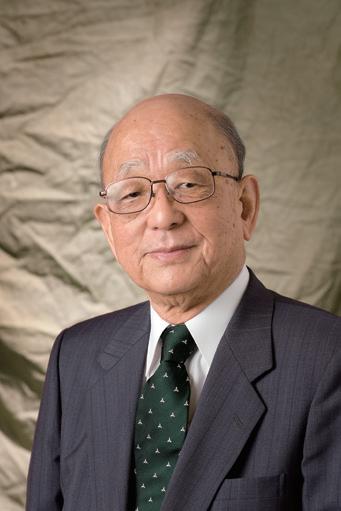

The Institute for Chemical Reaction Design and Discovery (WPI-ICReDD) is established.
The Institute for the Advancement of Sustainability is established.
The Sapporo Campus becomes part of the course for the Tokyo 2020 Olympic Marathon.
Dr. Benjamin List, WPI-ICReDD Principal Investigator and Specially Appointed Professor, is awarded the Nobel Prize in Chemistry.

Ranked 10th in the world (1st in Japan) in THE Impact Rankings 2022.
150th anniversary of the founding of Hokkaido University.
The University will celebrate the 150th anniversary of its foundation in 2026 during this mid-term goal period. The major milestone of this anniversary provides an excellent opportunity for a broader understanding of the University’s visions, which are presented on the following pages. Plans for education, research, and social cooperation that will gain the understanding and support of many stakeholders will be prepared. With this, from a

financial perspective, we hope to achieve a significant upward revision over and above the basic financial strengthening of the mid-term goal period.
Hokkaido University aims to be an unparalleled university with the message “Shining a light from Hokkaido upon the world.” Thank you for your continued understanding and support.
Born in Sapporo, 1954. Doctor of Medicine. Dr. Houkin graduated from the Hokkaido University School of Medicine in 1979, and has worked as a neurosurgeon at Hokkaido University Hospital and other private hospitals. He was appointed Director of Hokkaido University Hospital in 2013, and has held his current position since October 2020.
 Message from the President
02
Message from the President
02
be an unparalleled
A university that contributes to resolving global issues
Fourth Period of Mid-Term Goals and Mid-Term Plan (FY 2022 – FY 2027)
The Fourth Period of Mid-Term Goals and Mid-Term Plan started in 2022. Its six-year period will be crucial to the future of the University, coinciding with the milestone 150th anniversary of our founding.
The University has held thorough discussions on its visions for the end of the Fourth Period of Mid-Term Goals and has developed six visions to realize the Future Strategy for the 150th Anniversary of Hokkaido University and to achieve its mission as a national university. The Fourth Period of Mid-Term Goals and Mid-Term Plan were formulated as concrete measures to ensure the implementation of these visions.
During the Fourth Period of Mid-Term Goals, the University will also strengthen its ties with the local communities and various organizations while keeping an eye on the world and will strive to become an autonomous university that embodies the spirit of “thinking globally, acting locally”—in other words, a new model of a comprehensive community-based core university. To strengthen partnerships with diverse organizations and contribute to solving regional problems such as the need to decarbonize society, the declining birthrate, demographic aging, depopulation, and industrial decline: These involve the very realization of the SDGs and are listed as unique items in the core visions for the Fourth Period of Mid-Term Goals, which aim to make the University an unparalleled one.
Hokkaido University as a center of research leading the world from the North
To become a point of origin for knowledge that flows from Hokkaido to the world, the University will establish a system to lead the way in solving domestic and international problems and creating innovations by improving basic research capabilities and promoting applied research, such as the social implementation of research results.
Establishment of a world-class research center
The University will reform its educational system, from undergraduate through graduate school, starting with a review of the entrance examination system, in order to cultivate cross-cultural understanding and international communication skills and to foster advanced human resources with the ability to bring research results to society, aiming for a next-generation higher education system that also includes entrepreneurial education and recurrent education.
Recruitment and fostering of excellent young researchers
Graduate school reform
Promotion of recurrent education
Fostering internationally minded individuals who can play active roles in the world
Hokkaido University: leading the next generation of higher education Education
vision
The University aims to dramatically advance social collaboration and play a role as a major player in social change toward building an inclusive, decarbonized society through entrepreneurship and community creation. Through human resource development and the application of research results to regional issues, the University will improve the productivity of regional industries, create jobs, and drive cultural development.
The six categories are: Research, Education, Collaboration, Management, Data, and Finances. In each of them, specific ambitious measures are being pursued, and by effectively linking them, we aim to make our University one that contributes to resolving global issues and realizing the SDGs, thereby achieving a breakthrough toward becoming an unparalleled university.
Hokkaido University, a solid management body that moves and works Management vision
The University will establish a solid management system with the ability to interact and act through the realization of high-quality internal controls, the promotion of collaborative relationships between faculty and staff, and the promotion of university-wide motivation management via work-style reforms based on DX-oriented initiatives.
The University will reform itself to promote data-driven education, research, and industry–academia collaboration and will develop its strengths through the integration of academic fields, new academic collaborations, and industry–academia partnerships.
Hokkaido University as a financial ecosystem
The University will bolster its finances by increasing its own revenues, including managerial revenues, while passing on to the next generation a financial foundation for stable, autonomous, and sustainable university operations through necessary selection and concentration.
Realization of high-quality internal controls
Increased motivation of faculty and staff
Promotion of DX
Promotion of research based on IR data
Improvement of the quality of education by using IR for education
for the next generation
Increase in own revenues, including managerial revenues
Necessary selection and concentration of resources
Collaborative efforts by Hokkaido University through connections and expansion
Creation of leaders for regional revitalization
Establishment of a collaborative system to solve regional issues




The 2021 Nobel Prize in Chemistry was awarded to Specially Appointed Professor Benjamin List of the WPI-ICReDD and to Professor David MacMillan of Princeton University in the United States. Specially Appointed Professor List received the prize for developing asymmetric organocatalysis (2000), which he published on while at the Scripps Research Institute in the United States. Specially Appointed Professor List has participated in ICReDD since its inception. The List group is currently conducting research to further develop organocatalytic chemical reactions. Specially Appointed Assistant Professor TSUJI Nobuya, who serves as a co-principal investigator (Co-PI), says, “By combining conventional experiments with new technologies, we may be able to explore chemical reactions more efficiently and make even more interesting discoveries.” ICReDD works with the most outstanding researchers in the world to advance world-leading research in the field of chemistry.
University Professor Principal Investigator and Specially Appointed Professor, WPI-ICReDD

Director and Professor, Max Planck Institute for Coal Research, Germany
Professor Emeritus, University of Cologne, Germany
Co-PI and Specially Appointed Professor, WPI-ICReDD
TSUJI Nobuya
Dr. List, a WPI-ICReDD Principal Investigator and a specially appointed professor, receives the Nobel Prize in Chemistry
Associate Professor Pavel Sidorov is a researcher in information science who works primarily with machine learning to design new molecules, materials and chemical reactions.


Associate Professor Sidorov says of ICReDD: “I think it’s rare anywhere in the world for experimental, computational, and information science researchers to be able to collaborate under one roof. In the world of chemistry, there’s a limit to what one researcher can accomplish, and collaboration across different fields is essential. Here, world-class researchers exchange ideas, and if there’s an area where you can make use of your strengths, you can collaborate immediately. In addition to the artificial force-induced reaction (AFIR) method developed by Director MAEDA Satoshi of ICReDD for predicting unknown reactions, state-of-the-art theory can
be applied and cutting-edge machinery can also be used. Another major attraction is a culture that’s very supportive of young researchers and respectful of ideas from the field.” Associate Professor Sidorov has been leading his own group as a Junior PI since February 2022 and is taking on challenges in chemistry that are attracting global attention. High expectations are pinned on his future
Establishment of the Akira Suzuki Awards for outstanding achievements in chemical reaction development
The Akira Suzuki Awards were established in 2021 and are named after Professor SUZUKI Akira, the University’s first Nobel laureate in Chemistry. The awards were established to commemorate Dr. Suzuki’s 90th birthday and to recognize the achievements of researchers in Japan and abroad who have made outstanding contributions to the development of

Further evolution is expected with the construction of a new building

ICReDD is currently located in the Creative Research Institute building on the University’s North Campus, and the independent Northern Campus Area Research Building No. 8 (the ICReDD Building) is scheduled to be completed in 2023. The experimental buildings of all the groups will be gathered together, enabling researchers to collaborate more closely than ever before, which is expected to further promote interdisciplinary research.
For more information, please visit the website. https://www.icredd.hokudai.ac.jp/
Open communication space at ICReDD
A young leader in information science, accelerating chemical reactions with machine learningThe awards ceremony of March 12, 2022
Associate Professor AOSHIMA Yoko joined the Slavic–Eurasian Research Center at Hokkaido University in April 2020. She says, “The literature is extensive, and there’s no better research and teaching environment for researchers in this field.”

Associate Professor AOSHIMA specializes in the modern and contemporary history of Central and Eastern Europe and Russia. In particular, her research focuses on educational issues in the western border regions of the Russian Empire (e.g., Finland, the Baltic states, Poland, Belarus, and Ukraine).
She says, “The deep history of each region creates the context in which contemporary events occur and consciously or unconsciously forms part of the framework of people’s thinking and behavior. In the Ukrainian
situation, differences in historical perceptions may not factor directly into the war, but I believe that understanding the characteristics of regional history will help prevent people from being carried away by extreme, dualistic ideas.”
The Slavic–Eurasian Research Center is the only Joint Usage/Research Center in Japan for domestic and international researchers who conduct comprehensive research on the Slavic–Eurasian region (the former Soviet Union and Eastern Europe).
With an emphasis on the process of co-creation, the Center holds a number of symposiums and seminars to promote the sharing of results and exchanges among researchers in Japan and overseas.

Slavic–Eurasian Research Center
https://src-h.slav.hokudai.ac.jp/index-e.html


Associate Professor ishihara mai of the Center for Ainu and Indigenous Studies conducts research that closely involves minorities, drawing on her own experiences with her Ainu origins. In her book Chinmoku no Jidenteki Minzokushi (Silence: An Autoethnography), she describes the pain of Ainu who have been forced to remain silent about their origins and reveals the blind spots in Japanese society that form this background. Currently, under the theme of “silent connections,” she has been energetically visiting Fukushima, Minamata, Kansai, and elsewhere in an attempt to see Japanese society three-dimensionally by connecting the pain etched on the bodies of the people in each region, despite the qualitative differences in backgrounds.
She was also the first person in Japan to raise the issue of indigenous feminism and has cast a new perspective on feminism by discussing the experiences of Ainu, Okinawan, Korean, and other minority women in Japan, as opposed to the feminism that is traditionally discussed from the viewpoint of majority women.
She was appointed as a full-time faculty member of the newly established Global Station for Indigenous Studies and Cultural Diversity (GSI) in April 2021, taking on the challenge of addressing yet-undiscovered international
issues while deepening her collaborations with overseas researchers.
New publication
Kigokasareru Senjumin/Josei/Kodomo (Symbolized Indigenous Peoples/Women/Children)
Associate Professor Center for Ainu and Indigenous Studies ishihara mai

Associate Professor ishihara uses all lowercase for her English name to signify that she is an indigenous feminist.
The Center for Ainu and Indigenous Studies was established in April 2007 as a shared facility (research facility) of the University. Full-time faculty members who specialize in history, archaeology, cultural anthropology, museology, linguistics, and constitutional law are assigned to this Center to conduct research on the Ainu people and the indigenous peoples of various
other countries. They also work with the Ainu people of today in practical activities, such as passing on their culture, and provide expert advice to the national government on Ainu policy promotion.
Center for Ainu and Indigenous Studies
https://www.cais.hokudai.ac.jp/english/

The Global Station for Indigenous Studies and Cultural Diversity (GSI) was established in April 2021. It is working with indigenous communities, including the Ainu, on international joint research focused on resolving issues related to indigenous peoples around the world and on clarifying the nature of cultural diversity. Currently,

researchers from 10 countries including Japan (23 overseas unit members) are participating in the GSI, and the construction of an international indigenous research platform is underway.
Global Station for Indigenous Studies and Cultural Diversity https://gi-core.oia.hokudai.ac.jp/gsi/


Doctoral students are the future of science, technology, and innovation in Japan, but in recent years, the number of students entering doctoral programs and the percentage of graduates who enter such programs have been declining nationwide. Under these circumstances, the University is promoting graduate school reforms to improve the research environment, especially for
doctoral students, by concentrating the resources it has accumulated as a comprehensive research university, which is one of the strengths of the University. In April 2022, the Institute for the Advancement of Graduate Education was newly established to manage graduate education as a whole and resolve issues that are difficult for individual faculties and schools.
The fellowship programs are the driving force behind our graduate school reforms. Eligible doctoral students will receive a scholarship equivalent to living expenses and support for research and other expenses, allowing them to pursue their research with peace of mind.
The University’s main fellowship programs
Hokkaido University-Hitachi Joint Cooperative Support Program for Education and Research
Research Fellowship for Young Scientists

Hokkaido University Ambitious Doctoral Fellowship program

Hokkaido University DX Doctoral Fellowship program
The Hokkaido University DX Doctoral Fellowship program, which began providing support in December 2021, has received 467 out of the total 5,540 support slots nationwide, among the most slots of any university. The program is open to appropriately selected doctoral students in the humanities and the sciences.
In addition to providing incentive grants and research funding, this program focuses on assisting career development and giving nurturing content, and it aims to improve research based on students’ free ideas and independent research skills by providing a place for them to pursue ambitious integrated research. As one of these efforts, the Regional Future Society SOUZOU Project – From Imagination to Creation started in April 2022 based at EZOHUB SAPPORO.
Hokkaido University DX Doctoral Fellowship portal site https://sites.google.com/eis.hokudai.ac.jp/dxphd-fellow/


In December 2021, the University issued the Statement on the Promotion of Diversity & Inclusion and pledged to realize a university environment where no one is left behind, where the dignity of all members is protected, and where each individual takes pride in and respects each other, regardless of race, nationality, color, language, ethnicity, origin, religion, creed, gender, sexual orientation, gender identity, life events, age, disability, appearance, physical features, lifestyle, or any other personal attributes. With this statement as a starting point for many faculty members to recognize the current situation, all members—faculty, staff, students—are required to think about issues and to solve them.
Video promoting the Statement on the Promotion of Diversity & Inclusion Diversity at Hokkaido University as I see it https://www.youtube.com/watch?v=hXoKYKDmJZM

The full text of Hokkaido University’s Statement on the Promotion of Diversity & Inclusion is available on the University’s website at the link below. https://diversity.synfoster.hokudai.ac.jp/en/
To promote diversity and inclusion as a University-wide endeavor, the University established the Office of Diversity, Equity, and Inclusion on April 1, 2022. This independent new organization falls under the direct control of the President and replaces the previous Promotion Office of Research Environment for Diversity at the Center for Advanced Human Resource Education and Development. As the pillars of the initiative, three
divisions have been established: the Environmental Improvement Promotion Division, to raise awareness and improve the environment, the Female Researcher Development Support Division, to foster female researcher leaders and provide research support, and the Education Promotion Division, to provide diversity education for students and encourage doctoral advancement.
The University, in collaboration with Muroran Institute of Technology, Obihiro University of Agriculture and Veterinary Medicine, Kitami Institute of Technology, Amino Up Co., Ltd., and Nitto Denko Corporation, has established the Hokkaido Diversity Research Environment Promotion Council. As the representative organization of this Council, the University is promoting the development of a research environment that takes into account work-life balance, fostering female researcher and engineer leaders, and supporting the establishment of career paths for the next generation of female researchers.
Formation of industry–academia–government co-creation centers to realize the ideal society of the future
Life Design Center for Mind and Body (project leader: Specially Appointed Professor YOSHINO Masanori), together with Iwamizawa City, Sapporo City, Otaru City, and Hokkaido, strives to reverse the trend of declining birthrates by providing Japan’s first comprehensive preconception care starting in childhood to improve health literacy and gender understanding, with the aim of Realization of a society where people can live happily as they are with others and can Increase options for living by understanding mind and body

Carbon zero and Sustainable Energy and Food community (project leader: Professor ISHII Kazuei) conducts research and demonstration projects in Hokkaido, a base for food supply in Japan, as well as in Kyushu and other regions of Japan that are blessed with renewable energy and then applies the results to regions of the world where population growth is expected to increase, thereby contributing to the achievement of the SDGs goals while addressing social issues at home and abroad and achieving a carbon-neutral society.

In recent years, the southern Hokkaido city of Hakodate has experienced record low catches of squid and non-farmed kelp, the mainstay catches, due to changes in the marine environment and other factors. Against this backdrop, this project aims to realize a marine city of sustainable fishery by creating new industries and creating jobs for young people, with research on regional carbon-neutral (RCN) aquaculture at its core. Specifically, the project intends to achieve regional carbon neutrality in the aquaculture industry by combining the complete cultivation of king salmon, a first for Japan, with the complete cultivation of kelp and by using seaweed farming and natural seaweed to absorb the CO2 emitted by fish farming, thereby realizing an aquaculture industry of low environmental impact and high profitability, instead of a fishing industry that depends on extracting natural resources.
In implementing the project, the Regional Fisheries Co-Creation Center, a satellite of the Society Region Emergence Department, was established on the Hakodate Campus to strengthen industry–academia–region collaboration by matching the industrial needs of the region and businesses with the research seeds of universities and other research institutions. In addition, the center aims to develop and implement the human resources development program “CREEN” to educate young people who can contribute to the Hakodate area. This project is supported by The Project on the Promotion of Regional Industries and Universities (Cabinet Office).



At the Shizunai Livestock Farm of the Field Science Center for Northern Biosphere, research on livestock production systems, mainly grazing, is conducted on a vast 470-ha tract of land. All of the approximately 150 head of beef cattle raised here are Japanese Shorthorn (Wagyu). Cattle manure is returned as fertilizer to grassland and feed fields, minimizing the amount of manure brought in from outside the ranch and creating a land-use livestock production system that is also animal welfare-friendly. The Japanese Shorthorn produced at the Shizunai Livestock Farm was named “HOKUDAI Shorthorn” in the hope that the cattle raised in this way would encourage consumers to think about livestock breeding and the environment, and sales began in 2021 under the Hokkaido University brand name.
Building a sustainable fishery and marine city with fish and algae aquaculture at its core Toward the establishment of aquaculture that contributes to regional carbon neutrality
Salmon farming
Human resources development program“CREEN”
C: Creative&Cooperative
R: Realistic
E: Entrepreneurial&Energetic
E: ECO
N: Naturalized
Nurturing people Creating jobs
Developing an attractive city
Kelp farming Regional Fisheries Co-Creation Center School of Fisheries Sciences
Mariculture = underwater aquaculture “Mari” is derived from the Latin word for “sea” and “culture” from “cultivation,” meaning aquafarming, cultivation, culture, and more.
Hakodate Mariculture Project to nurture people, create jobs, and develop the cityPastured during the summer months HOKUDAI Shorthorn products
Ranked 10th in the World (1st in Japan) in THE Impact Rankings 2022 and 1st in the World for “SDG 2. Zero Hunger”
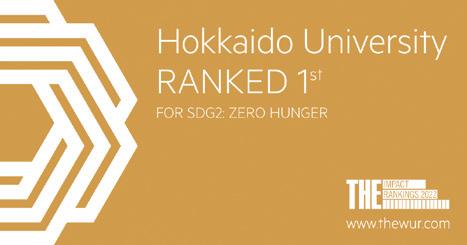
Times Higher Education, a UK-based higher education magazine, released THE Impact Rankings 2022 on April 27, 2022. The THE Impact Rankings assess universities’ contributions to achieving the United Nations’ Sustainable Development Goals (SDGs). Hokkaido University has become the first university in Japan to be ranked within the top 10 in the overall global ranking, out of the 1524 universities that entered the ranking, and 1st in the world in the category of SDG 2: Zero Hunger.
Out of the 17 SDG targets, the University was ranked within the global top 100 in the following categories; SDG 2: Zero Hunger (1st), SDG 17: Partnerships for the Goals (12th), SDG 14: Life Below Water (17th), SDG 15: Life on Land (18th), SDG 9: Industry, Innovation and Infrastructure (43rd), SDG 16: Peace, Justice and Strong Institutions (61st), and SDG 6: Clean Water and Sanitation (92nd).
Founded in 1876 as the Sapporo Agricultural College, the university has had strengths in food production, field science, and environmental sciences since its inception. Also, the university was the first National University to address sustainability by developing a Campus Master Plan in 1996, and it has made a number of progressive efforts toward SDGs since then, culminating in the establishment of the Institute for the Advancement of Sustainability last year. This remarkable result of the ranking is a recognition of the University’s longstanding efforts to achieve the SDGs.
10 =19 101- 200 101- 200 101- 200 101- 200 101- 200 201- 300 201- 300 201- 300 201- 300 201- 300 201- 300 201- 300
101- 200 101- 200 101- 200 201- 300 301- 400 101- 200 101- 200 401- 600 201- 300 101- 200 201- 300 201- 300 301- 400

THE Impact Rankings 2022 | Times Higher Education
Hokkaido University
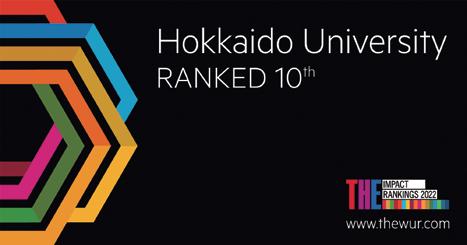
Kyoto University
Hiroshima University
Keio University
Kobe University
Tohoku University
University of Tsukuba
Kumamoto University
Kyushu University

Nagoya University
Okayama University
Osaka University
Ritsumeikan University Waseda University
Hokkaido University × SDGs: Introducing University initiatives for the SDGs

The Hokkaido University × SDGs website, which provides information on the University’s SDG-related initiatives from time to time, features interviews with faculty and students on their respective perspectives on the SDGs. The Faculty of Fisheries Sciences started offering Fish of the Month (FoM) educational content on marine life in September 2021, aiming to contribute to achieving the SDGs and improving food resource production technologies.

Hokkaido University × SDGs https://sdgs.hokudai.ac.jp/en/


Fish of the Month(FoM) https://edu.fish.hokudai.ac.jp/fom/
On February 17, 2022, the SDGs × Hokkaido Seminar 2022 was held jointly with the Hokkaido Government, attracting approximately 300 participants online. Associate Professor
KOBAYASHI Kuniyuki of the Research Faculty of Agriculture gave a keynote speech titled “Rural Development and SDGs,” which was followed by an introduction of the University’s SDG initiatives by Professor KATO Satoru of the Institute for the Advancement of Sustainability. Then, Hokkaido Asahikawa Agricultural High School outlined its research and study of organically grown flowers. The seminar concluded with a presentation from the Hokkaido Government on the progress of the SDGs in the prefecture.
HSI Team OMOTENASHI is an HSI*-accredited student volunteer organization that has planned and managed various international exchange events since FY 2021. In August 2021, the team organized the Hokkaido University Visual Tour as an HSI exchange event, and a student-guided campus tour was made open to the public. The team also organized the SDGs Challenge Competition 2021, an online English presentation contest in October 2021. This event was held to provide an opportunity for students from around the world to interact and exchange their diverse ideas with each other.
*Hokkaido Summer Institute: one of the University’s international program inviting world leading researchers, and the largest summer school in Japan.


HSI Team OMOTENASHI: Students create a place for students around the world to connect
Seminar co-hosted with the Hokkaido Government, and exchanges with an Agricultural High SchoolAssociate Professor KOBAYASHI gives a speech titled “Rural Development and SDGs”
In December 2021, amidst a major transformation in the nature of international exchanges, Hokkaido University formulated Global Vision 2040, which outlines the direction that the University should take from an international perspective for the mid and long term, up to the year 2040.
This international strategy sets three future visions which the University aims to pursue towards the year 2040 and presented two directions for realizing these visions.
The first direction is a shift from the quantitative expansion of education and research to an emphasis on quality. The second direction is the promotion of an international strategy for the digitalization of education. Under these two directions, four strategic target goals were established and specific initiatives were formulated. The international strategy is a road map to further enhance the internationalization of education and research at the University. It is expected that this strategy will be utilized for the advancement of the University that contributes to resolution of global issues in a long-term.
International Strategy “Hokkaido University Global Vision 2040” Outline 【Aspirations of Hokkaido University for the Year 2040】
1. To be a driving force in contributing to the resolution of global issues through partnership and collaboration with people from diverse countries, regions and organizations, and in creating a thriving future society.
2. To be recognized as an unparalleled university by contributing to the achievement of sustainability with originality and excellence through global education and research in diverse fields grounded in the history of the founding of the university, its unique development, and geographic characteristics.
3. To achieve an equitable and inclusive campus internationalization in which diverse students, researchers, and faculty/staff members thrive and excel.
Shift from “Quantitative Expansion” to “Emphasis on Quality” in Education and Research

The international strategy of Hokkaido University for 2040 is available on the University’s website at https://www.global.hokudai.ac.jp/about/international-strategy-of-hokkaido-university-toward-the-year-2040/
Promoting Appealing International Collaborative Co-Learning Environments
Practical Contributions in Areas of Sustainability
Developing Environment and Organization to Improve International Adaptability
Enhancing HR Development and Research Capabilities Through a Virtuous Cycle of Knowledge
Vitalizing Brain Circulation Students & Faculty with Cultural Fluidity
Pursuit of Sustainability Evolving Management
In FY 2017, to centralize data analysis resources at the University and strengthen their structure, the activities of Institutional Research (IR) for education were integrated into the Office of Institutional Research, resulting in the current two-division structure: “Corporate Strategy Analysis Division” and “Higher Education Research Division”. The
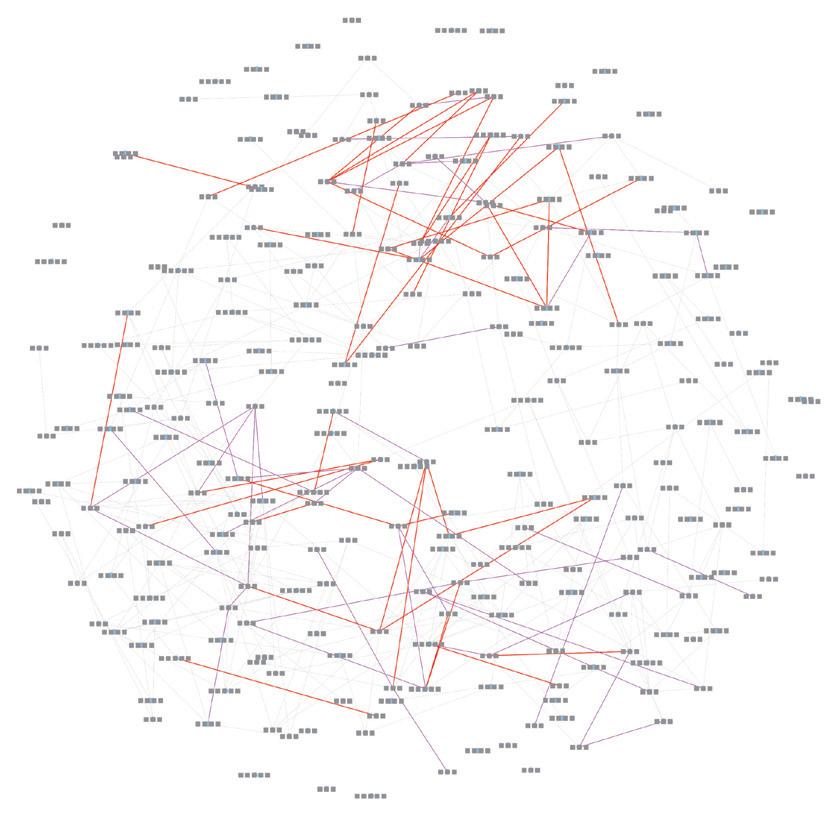
divisions work closely together to collect and analyze data and are steadily promoting data analysis that contributes to the formulation of the University’s management strategy while demonstrating the synergistic effect of integrating two IR divisions.
In June 2021, the Hokkaido Prime Bio-community, in which the University serves as the representative institution, was recognized as a Regional Bio-community in the formation of bio-communities promoted by the Cabinet Office.
Information science research area
Civil engineering research area
Computer and agricultural research area
Before this accreditation, the Office of Institutional Research provided its analytical tools that are related to interdisciplinary research areas to the Executive Office for Research Strategy, which led to the Regional Bio-community Concept.
The number of Hokkaido university’s research publications related to the respective research areas of A and B:
First place in Japan
Research area A Research area B Red line
Second place in Japan
Research area A Research area B pink line
Food science and nutritional research area
Biotechnology and microbiology research area
The information collected and analyzed by the Office of Institutional Research is compiled as the Hokkaido Fact Book, which provides various data on education, research, and administrative operations and is made available on the University’s website as interactive visualization data by
Hokkaido University Business Intelligence, for the purpose of fostering a common understanding of the University’s current status and issues among stakeholders and other parties concerned.
National university corporations prepare annual financial statements, clarify their financial and operational status, and submit these to the Minister of Education, Culture, Sports, Science and Technology for approval. The main financial statements are outlined here.
In FY 2021, assets increased by 3.6 billion yen due to an increase in cash and deposits, including time deposits, and the acquisition of securities.
In FY 2021, ordinary expenses increased by 6.3 billion yen due to an increase in personnel expenses, including an increase in retirement allowance payments. However, ordinary revenues increased by 8.4 billion yen from the previous year due to an increase in the amount of contract research and grants received. As a result, the current gross income increased by 3.8 billion yen to 5.9 billion yen. *Each amount is rounded down to the nearest unit, so totals may not agree.
The subsidy for operating expenses granted by the national government has been reduced by 8.3 billion yen compared to fiscal 2004, when the University was first incorporated. Therefore, it is necessary to improve management efficiency and take measures to increase own revenues from external funds and other sources. *The amount of money for each fiscal year is that received during the year and does not correspond to the operating subsidy income on the profit-and-loss statement, which is recorded according to the progress of operations, nor does the amount correspond to the operating subsidy income on the financial report, including the amount carried over from the previous year.
English page of the financial statements
https://www.global.hokudai.ac.jp/wp-content/uploads/ 2022/12/FY2021-Financial-Statements.pdf

The Hokudai Research & Business Park provides a favorable research and business environment through collaboration among Hokkaido University, the national government, local governments, and industry, aiming to promote cutting-edge research and development, develop new technologies and products utilizing intellectual property owned by universities and other institutions, and create venture companies and new industries. This activity has been developed to revitalize the economy and industry and to increase the scale of companies through joint research with companies in Hokkaido. There are plans to conduct strategic marketing to companies in the Tokyo metropolitan area for the development of large-scale joint research and to actively attract major corporations and venture companies to the North Campus and its environs by taking advantage of its geographical location.
By promoting these measures, the University aims to achieve a joint research revenue target of 3.2 billion yen, which is one of the goals of the Fourth Period of Mid-Term Goals and Mid-Term Plan.
While steadily fulfilling its mission, Hokkaido University Hospital is making various management efforts, such as reducing expenses by switching to generic drugs and reviewing assets (e.g., medical equipment) and increasing revenues by raising the number of surgeries and increasing the bed occupancy rate.
As the situation surrounding national universities becomes more severe, such as the reduction of subsidies for operating expenses, Hokkaido University needs your support to continue operating the university independently and to make a bigger contribution to society.
The foundation provided a non-repayable benefit-type scholarship with the aim of encouraging students of the Nitobe College Honors Program for Graduate Students to further develop their advanced expertise and their ability to utilize it.

I would like to thank the respected Frontier Foundation sponsors from the bottom of my heart for selecting me as a recipient for the Nitobe Scholarship. After receiving the scholarship, my quality of life has improved considerably and I have been able to allocate more time to towards my classes and career instead of focusing on my part-time job. I was
able to get a Scuba Diving License using a part of the funds and this will aid me in getting better samples for my research and kickstarting my career. Once again, I am grateful to the sponsors for this opportunity and will do anything I can in order to promote Nitobe College so that students will continue to have this opportunity in the future as well. (Rajagopal
Ranjani)
The Trillium flower is symbolic of Hokkaido University and used as its official logo. In this design, the flower symbolizes ʻʻhumanʼʼ by combining intelligence, individuality, and diversity. The overlapping elegant lines of the flowers represent human relationships and knowledge. The flowersʼ silhouettes reflect academic and contemporary values, suitable for Hokkaido University.
Hokkaido University Integrated Report 2022 (Abridged version in English)

Published by: Finance Management Section, Budget Division, Finance Department, Hokkaido University
Address: Kita 8, Nishi 5, Kita-ku, Sapporo, Hokkaido 060-0808, Japan Tel.: +81-(0)11-706-3991
E-mail: zaikan@finance.hokudai.ac.jp Published: December 2022
This English integrated report is also available on the website. https://www.global.hokudai.ac.jp/about/publications/integrated-report/